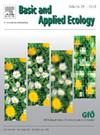Collectomics in plant biodiversity research − looking into the past to understand the present and shape the future
IF 3.5
2区 环境科学与生态学
Q2 ECOLOGY
引用次数: 0
Abstract
Global biodiversity is changing at unprecedented rates during the Anthropocene. Whereas current biodiversity patterns can be observed directly, information from the recent past is far less easily retrieved yet urgently needed to understand present observations and predict future developments. For plants, herbaria offer such a unique glimpse into the past. Evaluation of plant specimens allows determining a wide range of attributes like species identity, morphological and phenological traits and even signs of biotic interactions. Specimen’s labels convey data such as species identity (and identification history), date and locality of collection, as well as the surrounding biotic and abiotic environment. Current methodological developments in sensor technology and computer vision increasingly enable us to extract this information in a high throughput and automated way. Equally vast developments in data science allow to integrate data from other sources for much more comprehensive analyses than before. With millions of specimens already digitized and digitization schemes running in many institutions, we will be increasingly able to determine characteristics of species and link them via distribution records to large-scale climate change scenarios. This allows us to better predict species’ threat levels, and to develop scenarios on the consequences of biodiversity change for ecosystem functioning. The present contribution reviews recent herbaria research and describes potential avenues with respect to Museomics and the Extended Specimen, and we propose Collectomics as a new framework to unravel, understand, and cope with the Anthropocene biodiversity change.
植物生物多样性研究中的集体组学——回顾过去,了解现在,塑造未来
在人类世期间,全球生物多样性正在以前所未有的速度变化。虽然目前的生物多样性模式可以直接观察到,但从最近的过去检索信息要容易得多,但迫切需要了解目前的观察结果并预测未来的发展。对于植物来说,植物标本室提供了对过去的独特一瞥。植物标本的评估可以确定广泛的属性,如物种身份,形态和物候特征,甚至生物相互作用的迹象。标本的标签传递诸如物种身份(和鉴定历史)、采集日期和地点以及周围的生物和非生物环境等数据。当前传感器技术和计算机视觉方法的发展日益使我们能够以高通量和自动化的方式提取这些信息。同样,数据科学的巨大发展使我们能够整合来自其他来源的数据,进行比以前更全面的分析。随着数以百万计的标本已经数字化,以及许多机构正在实施的数字化计划,我们将越来越有能力确定物种的特征,并通过分布记录将它们与大规模气候变化情景联系起来。这使我们能够更好地预测物种的威胁程度,并就生物多样性变化对生态系统功能的影响制定情景。本文回顾了近年来的植物标本馆研究,并描述了博物馆组学和扩展标本学的潜在途径,提出了集体组学作为揭示、理解和应对人类世生物多样性变化的新框架。
本文章由计算机程序翻译,如有差异,请以英文原文为准。
求助全文
约1分钟内获得全文
求助全文
来源期刊

Basic and Applied Ecology
环境科学-生态学
CiteScore
6.90
自引率
5.30%
发文量
103
审稿时长
10.6 weeks
期刊介绍:
Basic and Applied Ecology provides a forum in which significant advances and ideas can be rapidly communicated to a wide audience. Basic and Applied Ecology publishes original contributions, perspectives and reviews from all areas of basic and applied ecology. Ecologists from all countries are invited to publish ecological research of international interest in its pages. There is no bias with regard to taxon or geographical area.
 求助内容:
求助内容: 应助结果提醒方式:
应助结果提醒方式:


